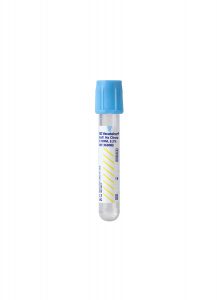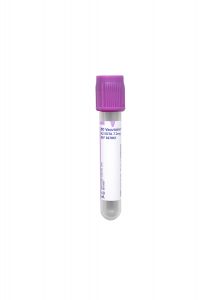Test Name
Hypercoagulation Diagnostic Interpretive Panel (HYPER)
CPT Codes
86147 (x3)
83090
85610
85730 (x2)
85300
85384
85306
85303
85240
85307
86140
85732
81240
85390
Methodology
Refer to individual components
Turnaround Time
3 – 5 days
Specimen Requirements
Specimen Type:
Serum
Volume:
2 mL
Minimum Volume:
1 mL
Collection Container:
Gold BD Hemogard™ Serum Separation Tubes (SST)™
Transport Temperature:
Frozen
Specimen Type:
Whole blood
Volume:
4 mL
Minimum Volume:
2 mL
Collection Container:
Lavender BD Hemogard™ K2EDTA Tube
Transport Temperature:
Frozen
Specimen Type:
Plasma
Volume:
6 mL
Minimum Volume:
3 mL (citrated plasma)
Collection Container:
Light Blue Sodium Citrate Coagulation Tube
Transport Temperature:
Frozen

Stability
Ambient:
4 hours
Refrigerated:
Unacceptable
Frozen:
14 days at -20°C
6 months at -70°C
Specimen Collection & Handling
Collection of blood by routine venipuncture in a 3.5 mL light blue top tube containing 9:1 ratio of blood to 3.2% trisodium citrate anticoagulant.
Patient Preparation
Discontinue coumadin therapy for 7 days, heparin therapy for 2 days, and thrombolytic therapy for 7 days prior to the test, if possible.
If tests are abnormal, the following tests may be ordered and billed:
Reference Range
Refer to individual components.
Additional Information
Background Information
Venous thromboembolism (VTE) is a major health issue, with more than 300,000 first-lifetime cases per year and around 1 million deaths annually in the United States alone. Thrombophilia (or hypercoagulability), although not a disease itself, is a major contributing factor in the development of VTE. Thrombophilia is the propensity to develop thromboses due to an acquired or inherited defect in the coagulation system. The predominant clinical manifestation of thrombophilia is venous thromboembolism.
Anti-phospholipid antibody syndrome (APS) is the most common cause of acquired thrombophilia. Additional causes include acquired or inherited deficiency of anticoagulant or procoagulant factors (e.g., protein C, protein S, antithrombin or fibrinogen), acquired or inherited elevation in procoagulant factors, such as factor VIII or homocysteine (>95th percentile). Inherited genetic mutations, including Factor V Leiden [FVL] and prothrombin gene, also predispose to thrombosis.
Not all abnormalities are associated with thrombophilia. For example, thrombophilic risk factors include advancing age (>50), major surgery, trauma, immobilization, malignancy, pregnancy, prior to oral contraceptive or hormonal replacement therapy, and chemotherapy. As with many disease-modifying risk factors, thrombophilic risk factors are synergistic — a combination magnifies the risk for thrombosis.
Acquired fibrinogen deficiency can occur in liver disease, disseminated intravascular coagulation (DIC), or hyperfibrinolysis. Acquired protein C or protein S deficiency can be associated with liver disease, anticoagulant therapy (warfarin), acute thrombosis, infections, DIC, postoperatively, uremia, or chemotherapy. Acquired antithrombin deficiency can be associated with DIC, liver disease, heparin therapy, acute thrombosis, nephrotic syndrome, or L-asparaginase therapy.
Currently, there is no single laboratory test that can identify all hypercoagulable defects; therefore, a combination of laboratory analyses is needed to accurately identify thrombophilic patients. Many of these tests are affected by other — often concurrent — clinical conditions so that the correct interpretation of these specialized laboratory test results can be complicated, and always require clinical correlation.
Clinical Indications
Patients with a personal or family history of unexplained or recurrent thrombosis and/or pregnancy complications.
May potentially be of benefit for screening patients who will be placed at increased risk of thrombosis.
Interpretation
This panel of tests is not simply reported as positive or negative; a narrative interpretation is issued for each patient panel.
Each test is reported separately, taking into account the patient’s clinical context.
Each positive test result increases the relative risk of thrombophilia independently of the other test results.
Limitations
Results from a hypercoagulability workup are difficult to interpret in the setting of acute thrombosis or anticoagulant medication therapy; thus, testing should be performed approximately 30 days after VTE or discontinuation of medication including warfarin, heparin, direct thrombin inhibitors (DTIs), and fibrinolytic agents.
Other clinical conditions (e.g. pregnancy, inflammatory states, liver disease, etc.) may affect certain assay results as well. The test requestor should provide appropriate clinical information in regards to these conditions to assist the laboratory in making the best possible interpretation of results. Alternatively, thrombophilic testing may be delayed until these clinical conditions have subsided.
Rarer thrombophilic mutations do exist for which testing is not currently performed. In this case, a patient may have an apparently-negative thrombophilic workup while still exhibiting a thrombotic phenotype. Clinical judgment is necessary to guide the therapy of these patients.
Methodology
Laboratory testing for thrombophilia consists of a panel of assays specifically performed together to maximize diagnostic potential.

Key:
Initial Core Panel Laboratory Testing
Reflex Testing, depending on Core Panel results
Thrombophilia Risk Factors
Abbreviations:
APTT: Activated partial thromboplastin time
CAC: Circulating anticoagulant assay (mixing study)
DRVVT: Dilute Russell’s viper venom test
PNP: Platelet neutralization procedure
PT: Prothrombin time
SNP: Single nucleotide polymorphism
Functional Testing
Anti-Phospholipid Antibody
APA, lupus anticoagulant
Automated and manual aPTT, and the hexagonal phase phospholipid dependence assay.
Protein S
A turbidometric clot-based assay.
If a deficiency is suggested, an antigen level can be measured for confirmation.
Protein C & Antithrombin
Chromogenic substrate assays in which the normal ability to cleave substrate molecules causes a color change.
If a deficiency is suggested, an antigen level can be measured for confirmation.
Activated Protein C Resistance
APC; a surrogate for the FVL mutation
An aPTT-based assay using the ratio of APTTs with and without additional APC.
If the ratio is decreased (<2), molecular testing is used as confirmation of FVL mutation.
Homocysteine Levels
Chemiluminescence immunoassay.
While the methylenetetrahydrofolate reductase (MTHFR) gene mutation may be confirmed by molecular methods, this usually is considered unnecessary.
Fibrinogen
Clauss variation of the thrombin time assay (clot-based).
Factor VIII
Clot-based assay.
C-Reactive Protein
Levels assist in determining whether Factor VIII and fibrinogen are elevated as part of an acute phase response.
Antigenic Testing
Specific Antibodies Against Cardiolipin
By ELISA assay.
If positive, antibodies against ß2 glycoprotein 1 are measured.
Protein S (Free & Total) Antigenic Testing
Testing may be performed to confirm and/or subtype a deficiency detected by a decrease in protein S functional activity.
Protein C Antigen Level
May be measured to confirm and/or subtype a deficiency detected by a decrease in protein C functional activity.
Antithrombin Antigen Level
May be measured to confirm and/or subtype a deficiency detected by a decrease in antithrombin functional activity.
Genetic/Molecular Testing
Prothrombin Gene (G20210A)
A single nucleotide polymorphism (SNP) in a regulatory region of the prothrombin gene (G20210A) accounts for most cases of elevated prothrombin.
This SNP is assayed by fluorescence melt-curve analysis.
Factor V Leiden
FVL may be confirmed (after a decreased APC-R result) by fluorescence melt-curve analysis.
References
1. Colman RW et al. Hemostasis and Thrombosis: Basic Principles and Clinical Practice, 5th Ed. Lippincott Williams and Wilkins (2006).
2. Heit J. Thrombophilia: Common Questions on Laboratory Assessment and Management. Hematology. 2007;127-35.
3. Kottke-Marchant K. An Algorithmic Approach to Hemostasis Testing. CAP Press (2008).


